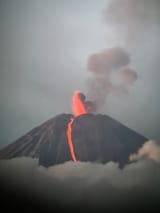Search Results
8/7/2025, 9:28:16 PM
Hilda Ellis Davidson theorizes that the events in Völuspá occurring after the death of the gods (the sun turning black, steam rising, flames touching the heavens, etc.) may be inspired by the volcanic eruptions on Iceland. Records of eruptions in Iceland bear strong similarities to the sequence of events described in Völuspá, especially the eruption at Laki that occurred in 1783.[58] Bertha Phillpotts theorizes that the figure of Surtr was inspired by Icelandic eruptions and that he was a volcano demon.[59] Surtr's name occurs in some Icelandic place names, among them the lava tube Surtshellir, a number of dark caverns in the volcanic central region of Iceland.[60] This viewpoint is expanded by recent research by Mathias Nordvig and Felix Riede, which connects the apocalyptic themes of Ragnarök to important geological and climatic occurrences in the sixth century AD. Massive volcanic eruptions created a "dust veil" at this time, which produced broad climatic changes throughout the Northern Hemisphere, including as longer periods of darkness and colder temperatures.[61] Known as one of the most intense volcanic winters in history, the years 536–550 AD brought about significant environmental changes in Scandinavia and shifts in settlement patterns during this time of climate disturbance, indicating a social reaction to these environmental issues.[61]
https://abcnews.go.com/amp/US/russias-major-earthquake-prompts-string-7-volcanic-eruptions/story?id=124351643
https://abcnews.go.com/amp/US/russias-major-earthquake-prompts-string-7-volcanic-eruptions/story?id=124351643
Page 1
